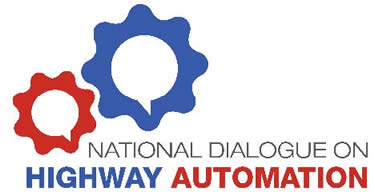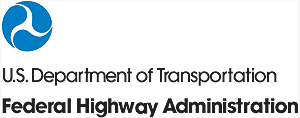FHWA National Dialogue on Highway Automation
Chicago, IL
September 5-6, 2018
PowerPoint Presentation Version [PDF 2.1MB]
You may need the Adobe® Reader® to view the PDFs on this page.
Contact Information: HighwayAutomation@dot.gov

Slide 1. FHWA National Dialogue on Highway Automation
Automation and Freight
Hyatt Regency, Chicago, IL
September 5-6, 2018
Slide 2. Levels of Automation

Slide 3. USDOT Modal Agencies and Roles

Slide 4. FHWA Authority and Role
FHWA has multiple roles:
- Administers the Federal-Aid Program
- Develops standards for infrastructure and traffic control devices
- Provides guidance to State and local agencies
- Conducts and supports highway research
- Serves as a resource for the transportation community
- and others….
Slide 5. USDOT Activities in Automation
Event |
Date |
USDOT releases Automated Driving Systems (ADS) 2.0: A Vision for Safety |
September 12, 2017 |
Roundtable on Data for Automated Vehicle Safety |
December 7, 2017 |
Public Listening Summit on Automated Vehicle Policy |
March 1, 2018 |
Automated Vehicles 3.0 release |
Late Summer 2018 |
Work Zone Data Exchange Project |
Ongoing |
V2X Mapping Stakeholder Input |
Ongoing |

Slide 6. What is Data for AV Integration?
- Access to data is a limiting factor for AV deployment across all modes
- Data exchanges can help increase access to data across traditional silos
- USDOT is using our convening power to understand critical needs for data exchange and the appropriate federal role to enable them, using a common language
For more information, visit https://www.transportation.gov/AV/Data and see the
Framework on Data for AV Integration handout.
Slide 7. FHWA Released RFI in March 2018
Select Themes
- Greater Uniformity and Quality in road markings and traffic control devices would enable automation.
- FHWA should take a Leadership role in convening stakeholders to encourage collaboration.
- Certain Data Elements about the roadway environment are useful for industry, State, and local DOTs to share and could improve automation operations.
- Conducting Pilots and supporting pilot testing are important for facilitating learning and collaboration.
- Uncertainty in infrastructure investment and allocation of limited resources are key concerns for State and local agencies.
Slide 8. Automation Has Implications for Roadways

Slide. 9 The National Dialogue on Highway Automation
Slide 10. What is the National Dialogue?
- The Federal Highway Administration (FHWA) is initiating a national conversation with diverse stakeholders to discuss automated vehicles.
- The National Dialogue on Highway Automation is a series of meetings held across the country to facilitate information sharing, identify key issues, and support the transportation community to safely and efficiently integrate automated vehicles into the road network.
Slide 11. What are Desired Outcomes?
FHWA may use inputs to:
- Assess National issues and priorities
- Develop guidance, best practices, standards
- Support necessary research
- Adapt programs and policies
- Create a National community or coalition
Slide 12. Workshop Schedule
Month |
Event |
Location |
June 7 |
National Dialogue Launch Workshop |
Detroit, MI |
June 26-27 |
National Workshop 1: Planning and Policy |
Philadelphia, PA |
July 12 |
Automated Vehicle Symposium
FMCSA-FHWA Truck Automation Listening Session |
San Francisco, CA |
August 1-2 |
National Workshop 2: Digital Infrastructure and Data |
Seattle, WA |
September 5-6 |
National Workshop 3: Freight |
Chicago, IL |
October 24-25 |
National Workshop 4: Operations |
Phoenix, AZ |
Nov/Dec |
National Workshop 5: Infrastructure Design and Safety |
Texas |
Slide 13. Launch Workshop
- FHWA has a clear role as a facilitator
- A national vision for automation will help clarify goals
- Clear communication about the technology helps to encourage public acceptance
- A lack of consistency (i.e. traffic control devices, policies) can hinder adoption
- Information sharing is important for enabling automated vehicles
- There will be a transition period of a mixed-vehicle fleet, which will require interoperability
Slide 14. Themes: Policy and Planning Workshop
- The transportation planning process may need to evolve to address uncertainty of AV impacts (e.g. congestion, land use)
- Infrastructure investment and funding to raise overall condition enables not only automation, but all road users
- Clearly defining roles and goals will help policy development
- State and local agencies need education, resources, and guidance to support organizational readiness
Slide 15. Data/Digital Infrastructure Workshop
- Data exchange can accelerate safe integration of AVs (see next slide)
- Important to achieve data standardization where useful and tangible
- Lifecycle management and upkeep of data is an emerging issue
- Further clarity needed around digital mapping --- who is building, level of detail needed, Federal role
- Above activities may necessitate development and linkage of systems and technologies
Slide 16. Freight
Slide 17. Opportunity Areas for Freight

Slide 18. Potential Issues for Discussion
- What are potential infrastructure impacts (e.g. size/weight impacts to bridges)?
- What are the different distribution networks and implications for roadway infrastructure (e.g. additional facilities near highway access points)?
- How will automated commercial motor vehicles (CMVs) navigate complex roadway environments and conditions?
Slide 19. Potential Issues for Discussion
- How will automated CMVs change operation of the supply chain and what will be the impacts on the transportation network?
- How could automation, combined with freight industry trends impact congestion?
- How will automated commercial vehicles interact of with general traffic?
- Others?
Slide 20. Workshop Agenda — Day 1
Time (CT) |
Agenda Item |
1:00 PM |
Introduction |
1:10 PM |
Opening Remarks |
1:10 PM |
National Dialogue Overview |
1:30 PM |
Small Group Instructions |
1:35 PM |
Small Group Session 1: Roadway infrastructure and condition |
2:45 PM |
Small Group Session 1 Report Out |
3:30 PM |
Break |
3:45 PM |
Collaboration Corner |
5:00 PM |
Wrap Up and Preparation for Day 2 |
5:30 PM |
End of Day 1 |
Slide 21. Workshop Agenda — Day 2
Time (CT) |
Agenda Item |
8:00 AM |
Kick-Off Day 2 |
8:15 AM |
Instructions for Small Groups |
8:20 AM |
Small Group Session 2: Operational design domains and safe traffic operations |
9:20 AM |
Small Group Session 2 Report-Out |
10:00 AM |
Break |
10:20 AM |
Preparing for Automated Vehicles: Freight Perspectives |
11:30 AM |
Lunch (not included) |
1:00 PM |
Small Group Session 3: What's Next? |
2:30 PM |
Wrap Up and Next Steps |
3:00 PM |
End of Day |
Slide 22. Contact:
HighwayAutomation@dot.gov







